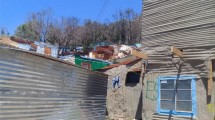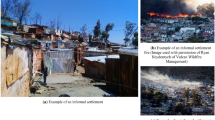Abstract
Large-scale urban conflagrations in informal settlements are a frequent global event, however there is a lack of experimental research and knowledge within literature on how informal settlements fires spread to support local or national intervention strategies. This paper, therefore, presents results and analysis of a full-scale fire spread experiment of a mock 20 dwelling test settlement with a 4 by 5 layout aimed at understanding settlement-scale fire spread behaviour. A “fire line” scenario was created by simultaneously igniting four dwellings in a row, and then allowing the fire to propagate through the settlement to replicate fire disasters involving large numbers of homes. Results highlight the critical hazard posed by the close proximity of neighbouring dwellings (1–2 m), with wind playing a primary role in directing and driving the spread process. Even with a relatively mild wind speed of 15–25 km/h, the fire spread through the entire mock settlement within a mere 5 min. Following ignition of a given dwelling, flashover is reached very quickly, with the temperatures reaching more than 1000°C within 1 min, and downwind neighbour structures igniting less than a minute thereafter. The results suggest that multi-dwelling effects are not dominant in these types of fires, but may become meaningful at a larger scale when branding and topography play a role. Findings show that on a global scale fire behaviour is analogous to a wildfire with a continuous fire front moving through an area, although individual dwellings still do follow the distinct phases of enclosure fires, except that collapse occurs more rapidly than in formal structures. This experiment represents one of the larger urban fire tests conducted to date, and the largest informal settlement fire experiment.












Similar content being viewed by others
References
Cicione A, Walls RS, Kahanji C (2019) Experimental study of fire spread between multiple full scale informal settlement dwellings. Fire Saf J 105:19–27. https://doi.org/10.1016/J.FIRESAF.2019.02.001
Hurley MJ, Rosenbaum E (2017) Performance-based fire safety design. CRC Press, Boca Raton
Quintiere JG (2006) Fundamentals of fire phenomena. Wiley, Hoboken
Bankoff G, Lübken U, Sand J (2012) Flammable cities: urban conflagration and the making of the modern world. University of Wisconsin Press, Madison
Quintiere JG (2017) Principles of fire behavior. CRC Press, Boca Raton
Walls R, Zweig P (2017) Towards sustainable slums: understanding fire engineering in informal settlements. In: Bahei-El-Din Y, Hassan M (eds) Advanced technologies for sustainable systems. Lecture Notes in Networks and Systems, vol 4. Springer, Cham
Walls R, Olivier G, Eksteen R (2017) Informal settlement fires in South Africa: Fire engineering overview and full-scale tests on “shacks”. Fire Saf J 91:997–1006. https://doi.org/10.1016/j.firesaf.2017.03.061
Antonellis D, Gill D (2018) A framework for fire safety in informal settlements. Arup, London
Himoto K, Shinohara M, Sekizawa A, et al (2018) A field experiment on fire spread within a group of model houses. Fire Saf J 96:105–114. https://doi.org/10.1016/j.firesaf.2018.01.003
Heskestad G (1991) A reduced-scale mass fire experiment. Combust Flame 83:293–301. https://doi.org/10.1016/0010-2180(91)90076-N
Quintiere JG, Carey AC, Reeves L, McCarthy LK (2017) Scale modeling in fire reconstruction. National Criminal Justice Reference Service (U.S.), Washington, DC
Bryner N., Johnsson EL, Pitts WM (1994) Carbon monoxide production in compartment fires: reduced-scale enclosure test facility. NIST Interagency/Internal Report (NISTIR), Gaithersburg, MD
Adou JK, Brou ADV, Porterie B (2015) Modeling wildland fire propagation using a semi-physical network model. Case Stud Fire Saf 4:11–18. https://doi.org/10.1016/J.CSFS.2015.05.003
Cicione A, Walls RS (2019) Towards a simplified fire dynamic simulator model to analyse fire spread between multiple informal settlement dwellings based on full-scale experiments. In: Interflam proceedings
Gibson LL, Rush D, Wheeler O, et al (2018) Fire detection in informal settlements. In: Chrysoulakis N, Erbertseder T, Zhang Y (eds) Remote sensing technologies and applications in urban environments III. SPIE, Bellingham. https://doi.org/10.1117/12.2501885
Countryman CM (1965) Mass fire characteristics in large-scale tests. Fire Technol 1:303–317. https://doi.org/10.1007/BF02588473
Morrison A (2018) 5 year climate summary for Worcester, Cape Weather, Cape Town, South Africa
ISO (2016) ISO 9705-1:2016–reaction to fire tests—room corner test for wall and ceiling lining products—Part 1: test method for a small room configuration. International Organization for Standardization
Kahanji C, Walls RS, Cicione A (2019) Fire spread analysis for the 2017 Imizamo Yethu informal settlement conflagration in South Africa. Int J Disaster Risk Reduct. https://doi.org/10.1016/J.IJDRR.2019.101146
Buchanan AH, Abu A (2017) Structural design for fire safety. Wiley, Chichester, West Sussex
Hidalgo JP, Maluk C, Cowlard A, et al (2017) A thin skin calorimeter (TSC) for quantifying irradiation during large-scale fire testing. Int J Therm Sci 112:383–394. https://doi.org/10.1016/j.ijthermalsci.2016.10.013
Cruz MG, Alexander ME (2019) The 10% wind speed rule of thumb for estimating a wildfire’s forward rate of spread in forests and shrublands. Ann For Sci 76:44. https://doi.org/10.1007/s13595-019-0829-8
Magnusson SE, Thelandersson S (1970) Temperature-time curves of complete process of fire development: theoretical study of wood fuel fires in enclosed spaces. Acta Polytechnica Scandinavica Publ. Office, p 181
Linn RR, Cunningham P (2005) Numerical simulations of grass fires using a coupled atmosphere–fire model: Basic fire behavior and dependence on wind speed. J Geophys Res 110:13107. https://doi.org/10.1029/2004JD005597
Beer T (1991) The interaction of wind and fire. Boundary-Layer Meteorol 54:287–308. https://doi.org/10.1007/BF00183958
Trelles J, Pagni P (1997) Fire-induced winds in the 20 October 1991 Oakland hills fire. Fire Saf Sci 5:911–922. https://doi.org/10.3801/iafss.fss.5-911
Węgrzyński W, Lipecki T (2018) Wind and fire coupled modelling—Part I: literature review. Fire Technol 54:1405–1442
Simeoni A (2016) Wildland Fires. In: Hurley MJ (ed) SFPE handbook of fire protection engineering. Springer, New York, pp 3283–3302
Acknowledgements
This research was funded through the Global Challenges Research Fund (GCRF) EPSRC Grant No. EP/P029582/1. The experiment would not have been possible without the valuable support and cooperation from the Breede Valley Fire Department (especially Fire Chiefs Theo Botha and Josephus Pretorius) and the Western Cape Disaster Management, Fire and Rescue Services.
Author information
Authors and Affiliations
Corresponding author
Additional information
Publisher's Note
Springer Nature remains neutral with regard to jurisdictional claims in published maps and institutional affiliations.
Rights and permissions
About this article
Cite this article
de Koker, N., Walls, R.S., Cicione, A. et al. 20 Dwelling Large-Scale Experiment of Fire Spread in Informal Settlements. Fire Technol 56, 1599–1620 (2020). https://doi.org/10.1007/s10694-019-00945-2
Received:
Accepted:
Published:
Issue Date:
DOI: https://doi.org/10.1007/s10694-019-00945-2




